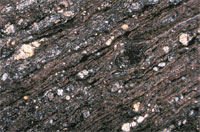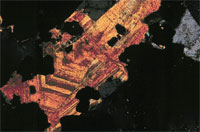



NDSU Geosciences Petrology 422/622 Spring 2012
STUDENT TERM PROJECTS


Our objective during the last section of the class is to exercise our petrology muscles, by gaining some hands-on knowledge of a specific petrologic topic, and by presenting the results of our research to an audience.
Topic Selection: Working in teams of one or two, select an igneous or metamorphic site or suite of samples that is of particular interest to you. There are a number of sample suites available in the department from previous field trips. Those of you going on a spring break trip may be able to collect samples that could be used for a project, but remember, it will take time to have thin sections made up (we send them to a commercial lab), so you'll have to work quickly upon return to get them back in time to prepare your project. You may also carry out a mathematical or geochemical modeling project based on literature data. All topics must be approved.
Titles Due: Term project titles should be turned in to me by Friday, March 9.
Research: Investigate your samples thoroughly by observing hand samples and thin sections. Chemical or SEM microchemical analysis may be possible, and XRD facilities are available in the Chemistry Dept. Carrying out relevant experiments is also a possibility. Thorough analysis of data from the literature on your sample area may be possible as a research project, but this type of project must be much more than a "book report." You are encouraged to use diverse source materials, including maps, state and federal reports, journals and books to provide background information for your project. Your project should include significant content based on your personal efforts. Be creative!
Class Presentation: For your 15 minute presentation to class, describe what motivated you to study the chosen topic, the geologic background of your samples, and a summary of the results of your research, with diagrams or pertinent data. Bring sufficient copies of a one-page double-sided summary to class. Include a "references cited" section that lists those materials that you actually used in the preparation of your report.
Presentation Dates: Presentations will be made on April 26, May 1, and May 3.
Course Points: 25% of grade
|
|
Projects: Thursday, April 26 Jordan Cahill Title: Ore mineralogy of the Ken Snyder / Midas deposit, Nevada I am researching a sample from the Ken Synder (now Midas) Ag-Au Mine in Nevada. I will use transmitted and reflected light microscopy along with SEM-EDS to determine the composition of the vein itself and the ore minerals in it. Ben Torgerson Title: Geothermometry of Black Hills Schists I will carry out geothermometry of a Black Hills schist sample collected from near Keystone, SD. I will begin by describing the garnet schist in hand sample and thin section. Next I will discuss the process of the garnet-biotite exchange geothermometer. In summary of the process, I will be attempting to determine the ratios of Fe and Mg in the garnet and biotite in order to estimate the pressure and temperature in which the schist formed. SEM analysis will be used in my efforts to reconstruct the environment in which the Black Hills schist from Keystone formed. Darin Slusher and Ashley Breiland Title: Characterization of a Roof Strike Rock, West Fargo, ND Our project is the “Roof Strike” mystery rock. The goal is to identify the “green” portion of the rock. The original goal was to identify both the green portion and the silicate veins coursing through the rock, but, it was decided that both may be too ambitious due to time constraints. This rock emanated from a specific location above a factory in West Fargo which then accelerated toward earth penetrating the roof of the factory. Our goal is to determine the composition of the rock via XRD, XRF, thin section analysis, and SEM testing. Preliminary photos, weight, specific gravity, and cutting of the rock have already been done. Once composition has been determined, we can then speculate as to what portions of the region, whether local or not, this rock could have ultimately emanated from. R.J. Glander and Mitch Halseth Title: Comparison of Devils Tower and Bridal Veil Falls Intrusion Geochemistry We will compare the geology of the rocks of Bridal Veil Falls to a sample from Devils Tower. We will carry out a mineralogical and chemical composition comparison between the rocks from the two locations to see how related they are to each other. We will carry out XRD and XRF analyses on both samples. Tuesday, May 1 Cole Jack and David MuellerTitle: Sphalerite from the Red Dog and the Tres Marias Mines: Not Only Zinc and Stink In our project we will be comparing and contrasting the Red Dog Zinc mine, and the Tres Marias mines. Both produce zinc but our main objective is looking at the sphalerite found in the samples. We will carry out SEM-EDS analyses to determine the composition of the sphalerite and the other minerals found in the samples. Once data is collected, we will be able to determine which mine is more economical in producing zinc with the amount of sphalerite found.
Rachel Powers and Felix Zamora
Alero Ajogri and David Lukudu Title: Investigation of an unknown metamorphic rock from Brazil A project of an unknown metamorphic rock collected in Brazil. We will be identifying the rock sample by using color, texture, an density to describe the hand specimen, also using an x ray diffraction, XRF and SEM to understand the chemical composition by using, and also a thin section will be view under microscope in order to identify the minerals and also know the percentage composition. Austin Dusek Title: Geochemistry and Interpretation of a Sample from Mount Vesuvius Garrett Houghton and Steve Bruins Title: Combustion Metamorphism of Clay Sediments from Western ND Our project will investigate a sample of 'clinker' or 'scoria', a type of pyrometamorphic rock we collected in western North Dakota. We will determine its composition, determine how it is different from its parent material, what pyrometamorphic feature it would be classified as, and provide ideas on how it may have formed. Thursday, May 3 Kilynn Sandberg and Sara Evanoff Title:Experiments on Ba Diffusion in K-spar Our project is a melting experiment on Potassium Feldspar. We will melt the K-spar in a furnace and add Ba as a trace element into the melt. From there we plan on trying to measure how far the trace element absorbed into the mineral, to see if it is indeed interchangeable with K-spar's chemical formula. We plan on using several thermodynamic equations to help calculate the heat and absorbtion process. We discused using XRD or SEM on our finished experiment, once it has cooled. This will help determine the amount of absorbtion. Neil Dotzenrod and Kevin Beidelman Title: Geochemistry of a Granite Collected Near Pullman, WA Our project is the characterization of a rock sample collected south west of Pullman, Washington on the Wawawai River Road south of Wawawai Country Park. The sample was collected at N 46° 36.429, W 117° 21.809. The rock sample in question appears to be granitic in nature. We will be using several techniques to determine exactly what kind of rock it is, along with its composition. These techniques include XRD, XRF and microscopic analysis.
Levi Moxness Jack Hoeven Title: Investigation of a Sample from Big Sky Mountain, Montana For my project, I am using a sample that was taken from the peak of Big Sky Mountain in the South of Montana. After doing some minimal research, I have discovered that my sample comes from an area that is pyroclastic material. I hope to finalize this idea by using XRD, XRF, and examining a thin section of my sample. Also, after working on the volcanics lab in petrography,I am thinking that my sample could possibly be a rhyolite or similar to a rhyolite. Carrie Fagerland Title: Description and Classification of Mylonites from Northern Patagonia, Argentina I will research samples from the El Cuy Region, Argentina to try to understand the structural geology. I will be looking for a sequence within the mylonites. Some samples have chevron folds and other metamorphosed features. I will carry out thin section and hand sample analisis, as well as literature research. 
NDSU Home | Geosciences Home | Petrology Home Page | B. Saini-Eidukat Petrology Geology 422/622 |